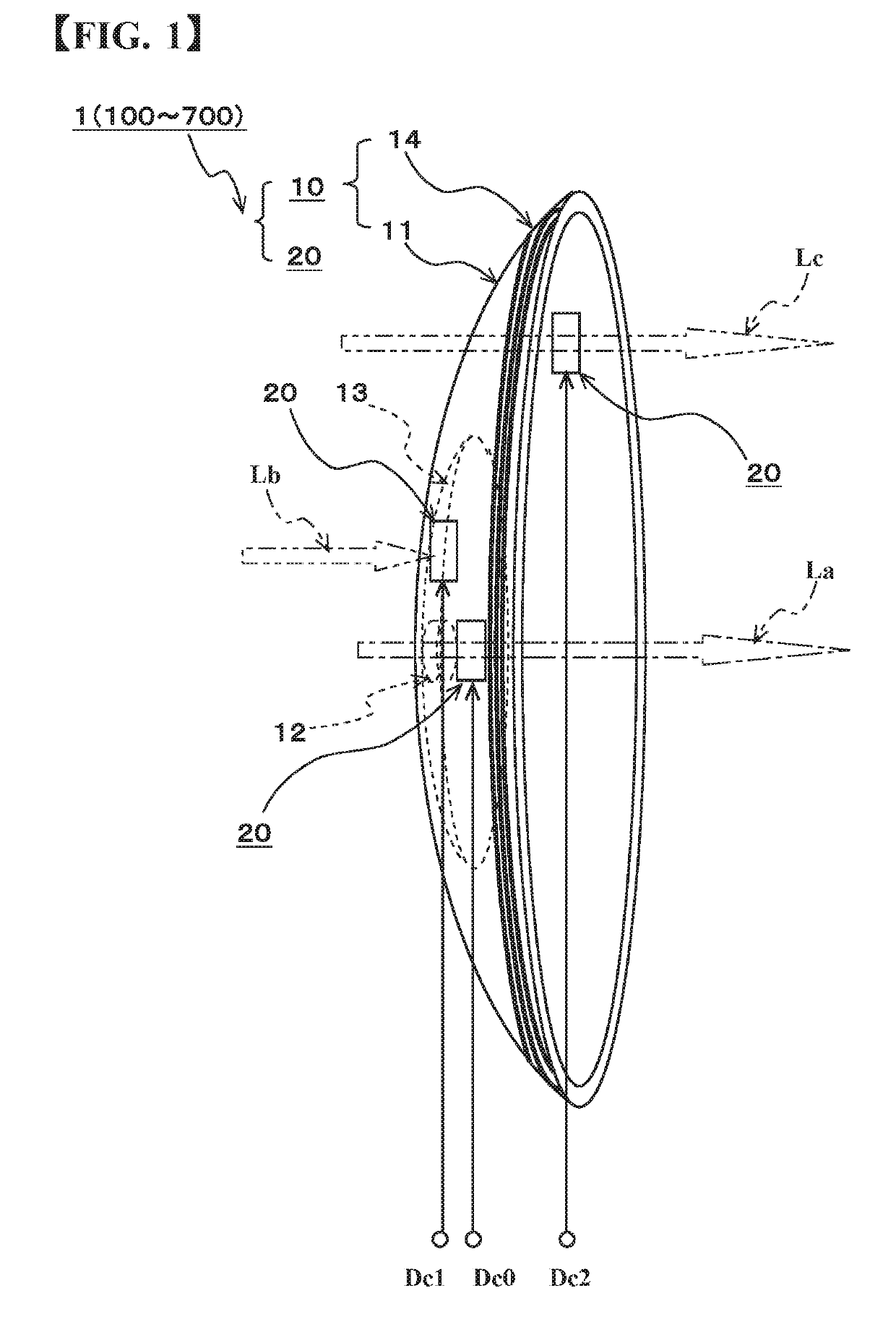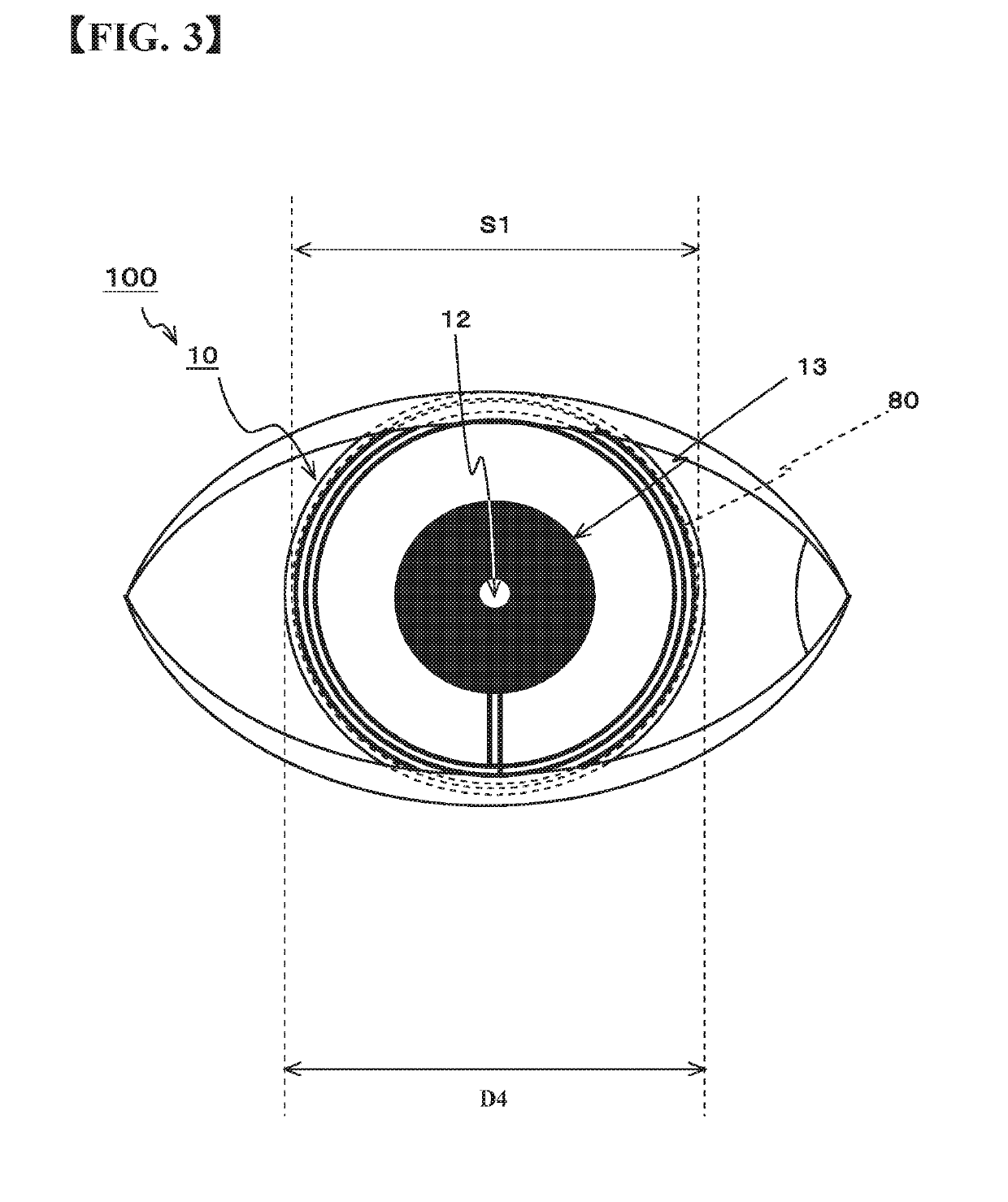Pinhole contact lens and smart contact system
a technology of contact lens and smart contact system, which is applied in the field of pinhole contact lens, can solve problems such as myopia or hyperopia, and achieve the effects of reducing light diffraction, improving the quality of pinhole image, and high functionality
- Summary
- Abstract
- Description
- Claims
- Application Information
AI Technical Summary
Benefits of technology
Problems solved by technology
Method used
Image
Examples
first embodiment
[0076]A pinhole contact lens 1 shown in FIG. 1 is a smart contact lens, and represents a configuration example of any of the pinhole contact lenses 100 to 700 of each embodiment according to the present invention which will be described later. Hereinafter, the configuration example of the pinhole contact lens 1 according to each embodiment will be described using the pinhole contact lens 100 of the first embodiment. In the pinhole contact lenses 200 to 700 of the second to seventh embodiments, the same components as those of the pinhole contact lens 100 of the first embodiment are denoted by the same codes, and the detailed descriptions thereof will be omitted. The pinhole contact lens 100 has a pinhole lens member 10 fittable on the cornea of a person and an electronic member 20 in FIG. 1. The pinhole lens member 10 has a lens member 11. A pinhole region 12 is arranged approximately at the center of the lens member 11, and a beam of light La passing through the pinhole region 12 co...
second embodiment
[0114]In this embodiment, the control unit 25 executes the brightness correction mode. For this reason, the light-shielding region 13 of the pinhole contact lens 200 shown in FIG. 8 is devised. The light-shielding region 13 has the pinhole region 12 and a plurality of (many) holes 15. The liquid crystal display elements 24 are installed to close all or some of the holes 15. Each of the liquid crystal display elements 24 may be arranged either on the upper surface side or on the lower surface side of the light shielding member 13′ as long as the holes 15 can be selected. Although, in FIG. 8, the liquid crystal display elements 24 are arranged in the right half for the sake of convenience in order to explain the distribution of the holes 15, but, of course, are arranged also in the left half. In the relationship between the holes 15 and the liquid crystal display elements 24, a plurality of holes 15 may be selected for one pixel, or one hole 15 may be selected for a plurality of pixel...
third embodiment
[0129]In the third embodiment, the control unit 25 executes the alignment assistance mode. Therefore, the liquid crystal display element 24 is formed in the pinhole region 12 as in the pinhole contact lens 300 shown in FIGS. 10A and 10B. For example, the opening part itself for forming the pinhole image on the retina 86 of the wearer is formed from the liquid crystal display element 24. For the liquid crystal display element 24, for example, PLCD liquid crystal can be used. The PLCD liquid crystal controls transmission of light based on the presence or absence of charge, and, in the case of the reverse type, transmits light in the absence of charge. Of course, the liquid crystal display element 24 is not limited to the PLCD liquid crystal.
[0130]In this embodiment, first, in a step ST11 shown in FIG. 11, the control unit 25 waits for the setting of the alignment assistance mode. When the external device 90 approaches the pinhole contact lens, the wireless communication unit 22 and th...
PUM
 Login to View More
Login to View More Abstract
Description
Claims
Application Information
 Login to View More
Login to View More - R&D
- Intellectual Property
- Life Sciences
- Materials
- Tech Scout
- Unparalleled Data Quality
- Higher Quality Content
- 60% Fewer Hallucinations
Browse by: Latest US Patents, China's latest patents, Technical Efficacy Thesaurus, Application Domain, Technology Topic, Popular Technical Reports.
© 2025 PatSnap. All rights reserved.Legal|Privacy policy|Modern Slavery Act Transparency Statement|Sitemap|About US| Contact US: help@patsnap.com



